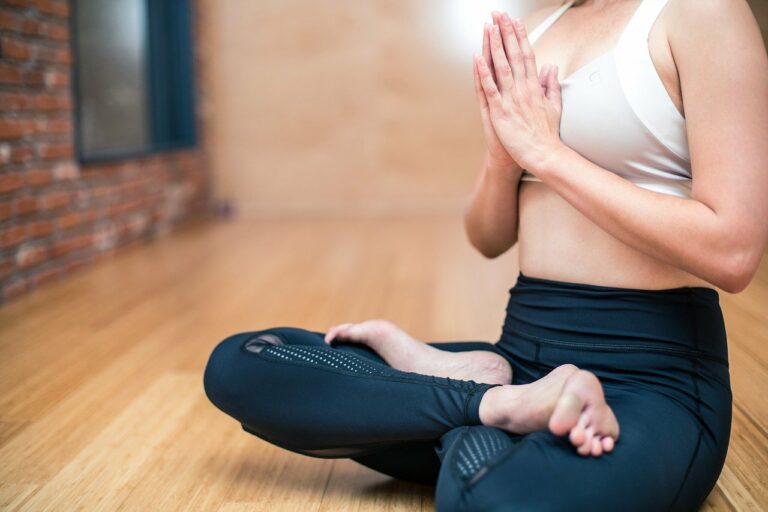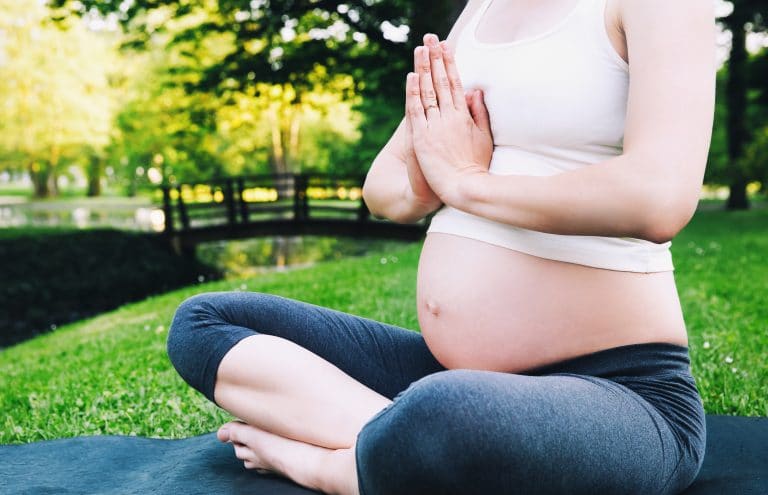Pregnancy and childbirth are monumental moments of life, and they put us through a whirlwind of emotions. The mother, in specific, experiences a lot physically too and gets rewired into a new person in the entire process. It is believed that the woman takes rebirth in the process of delivering her own child. It creates quite a confusion for this new mother to understand her transformed self while taking care of the newborn, and you wouldn’t wonder why postpartum depression has become common. Postnatal Yoga helps you know yourself from within, gain your energy back, get back in shape, and alleviate postpartum depression.
In This Article
What is Postnatal Yoga?
Postnatal Yoga is also called postpartum Yoga. It is a restorative and regenerative form of Yoga that helps women combat the physical and mental stress and fatigue they carry post-delivery. It helps address the most common and basic concerns such as the weakened pelvic floor, back pain, mood swings, postpartum depression, and fatigue.
Postnatal Yoga focuses on restoring the body and mind, empowering perinatal women through stretching, strengthening and breathing techniques. It’s one hour long with periods of holding poses to help postural alignment and relaxation as well as simplified sun salutations building up to seated stretches and backbends.
This class comes after three months (postpartum) or 4-6 weeks (pre- or early-pregnancy). Studies indicate that yoga reduces stress during pregnancy, lowers maternal anxiety levels – postpartum depression rates drop by 50% in those who practice it regularly – and provides prenatal benefits such as better sleep, fewer aches and pains during pregnancy.

Benefits of Postnatal Yoga
Postnatal Yoga is a type of yoga that focuses on strengthening, stretching and toning the muscles surrounding the pelvis. It’s designed to improve flexibility in all areas of your body, which helps with recovery after pregnancy. Postnatal yoga can help you regain strength in your stomach muscles and pelvic floor, while encouraging good posture. After birth or miscarriage, it can also help relieve back pain associated with carrying extra weight around the middle section for nine months. If you are looking for an effective workout routine post-pregnancy then this might be just what you need!
1. Know your Body
Yoga is a medium that helps to understand yourself better, both at a physical and emotional level. The deep and conscious breathing techniques practiced while performing the poses allow you to unwind your thoughts and explore your inner strength and potential. The mother’s body undergoes a gamut of changes to nurture the fetus inside the womb and experiences things like Braxton Hicks Contractions, rupture of membranes (water breaks), changes to the cervix, and the actual labor. The pain endured during labor is subjective, and it varies. In my case, it was as bad as breaking a bone. I endured the pain for a good 12 hours before the delivery while my friend walked out with the baby in just 4hrs of time with mild to moderate pain. I would say I have become much stronger after delivering my son physically and emotionally, which was no less than being reborn as a new me.
2. Posture Perfection
Your posture takes the biggest hit after the entire journey of pregnancy and childbirth. It can be the most ignored aspect considering the rush life speeds into after the baby’s arrival, but posture correction is essential. Developing a slouch is quite common after carrying the baby all these months, and the strain that the spine experiences during delivery doesn’t need a mention. Yoga helps you to retain the perfect posture, which indirectly boosts your confidence.
3. Boost Endurance
Loss of strength and stamina during the process of pregnancy and childbirth is common. Postnatal Yoga is specially designed for mothers and addresses these issues. It helps them gradually regain their strength and endurance levels while also working on their emotional calmness.
4. Mood Moderation
Postpartum depression could be an uninvited guest that might cause mood fluctuations. The conscious efforts of practicing Yoga with the right breathing techniques help to relax and unleash all the unwanted stress making you feel deeply relaxed.
5. Hormonal Balance
Postnatal Yoga helps reduce the pressure on the nervous system and helps minimize the effect of carrying the baby for nine months. It helps restore the hormonal balance of the body and pushes it slowly towards improving the core strength.
6. Psychological benefits
In addition to mood moderation, Yoga can help improve the psychological health of an individual and can make them strong from within. While stress is inevitable for any person, the intensity of stress is considerably high in new mothers due to the worries that keep popping into their minds about their baby. Yoga helps big time in managing stress.

Quick Tips of Postnatal Yoga
-
If you had a normal and natural delivery, you could start your stretching anytime after six weeks. But if you had a C-section, it is recommended to start after a good 20 weeks of delivery. In either case, consult your doctor before starting with any workout to avoid injuries. Start with mild-paced walking for at least 10 minutes every day during your initial waiting period before getting into Yoga.
-
Remember to choose the intensity of the workout based on your fitness quotient before and during pregnancy. If you are joining a class, you can discuss this with your trainer but if you are doing something all by yourself at home, exercise with caution. You could opt for deeper stretches only if you worked out regularly before and during pregnancy too.
-
You might have been consistent with your workout sessions before pregnancy, but if your medical condition demands rest during your pregnancy and if you have been under complete bed rest, please start with your postnatal workout sessions as a beginner only. Let your body begin slowly.
-
Try to join a postnatal Yoga class at a studio or even online where you could interact with moms sailing in the same boat. You could find friends to discuss and gain moral support too.
-
If you are a breastfeeding mom, try to feed your kid and then start your workout session. You would feel much lighter to move. It would also keep you at bay from leaky breasts caused due to the letdown reflex. On the other hand, you could also take your time to stretch while your kid is happy and tummy full.
-
If you are someone who had an episiotomy (a cut through the area between the vaginal opening and the anus) during your delivery process, I would take as much time as I need to heal. Do not commit the mistake of calculating the 6-week period, to begin with, your workout, take it slow. Start only when you are ready and get the approval of your doctor.
-
Hydrate yourself and munch on a protein bar right after the exercise to avoid any dip in your energy levels. Remember that you are on a 24/7 duty as a mom with your kid. Focus on what you eat, don’t go for Junk.
Basic Poses to Kickstart
Just like any other Yoga session, you would need the right mat, to begin with, the basic poses. But it would be great if you could have a bunch of support gear, like Yoga blocks, belts, bolster, straps, etc., that could help the transition back to exercise and fitness easily. After all the physical strain that the body undergoes, these props help a big time in your healing without leaving the minutest chance for any injury. Some basic poses that you could start once your doctor approves are listed below.
-
Stretching – Begin your workout session only after stretching your neck, shoulder, chest, and feet. This helps prepare your body to take full advantage of the Yogic poses that are to follow and work as the perfect warm-up.
-
Pelvic Floor Exercises – The best part of pelvic floor exercises is that they can be done while lying down. Kegels, bridge, and posterior pelvic tilts are some of the common exercises.
-
Child’s Pose – This is a very natural and simple pose. It helps to stretch your upper back and lower back muscles.
-
Bridge Pose – This pose alleviates the thoracic spine discomfort that arises after childbirth. It opens the chest and shoulders while stretching the hip flexors. All these body parts become tight after childbirth, and this pose can be soothing.
-
Cow Face Pose – This pose helps nursing mothers combat the shoulder hunch. It stretches the neck, shoulders, and hips.
-
Happy Baby Pose – Just as the name suggests, this pose resembles a happy baby. It stretches and comforts your spinal muscles while also working on other muscle groups of the body with its slow rocking motion.
-
Tiger Pose – This pose helps rejuvenate the reproductive organs and alleviates back pain. Try to wear a body shaper if it is comfortable, and this avoids the further sag of the loose skin around the tummy when you are on your fours.
-
Cobra pose – This Asana strengthens the spine, shoulders, arms, and buttocks. It helps alleviate the back pain, which is commonly triggered after a delivery.
-
Camel Pose – This pose helps to reduce the weight around the tummy. It strengthens the spine and tones your upper body. Do not attempt this pose without getting a go from the doctor. The stretch in the abdominal area could be troublesome if your body isn’t ready.
-
Corpse Pose – It is the final pose after any Yoga session to calm your mind and body. Lie down and stretch your arms alongside your torso. Close our eyes and relax. You can check out this article on Corpse Pose to understand why it is so important.
Conclusion
Postnatal Yoga could be the solution to all your needs as a newbie mom but remember not to be in a rush for weight loss or toning. Keep your body flexible and consistently train it over a period. Do not miss this fabulous period of enjoying motherhood with your little one but try to find a fine balance with your workout sessions. After all, you and your health are important too!
This Article is Written by Sri Lakshmi and Devina, both are part of the team of yogic-experience.com. Sri Lakshmi is a fashion enthusiast, full-time mother, Yogini, and Chief Editor. Devina is a 500-hours certified Pre and Post-Natal yoga trainer.











